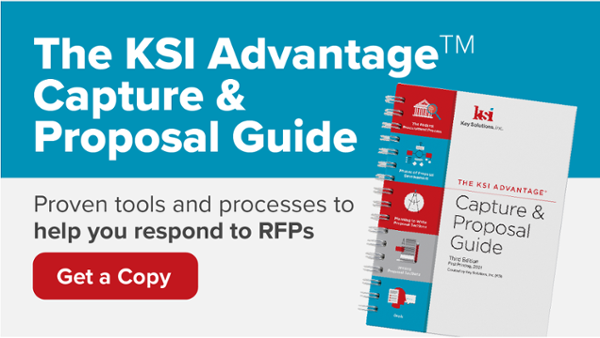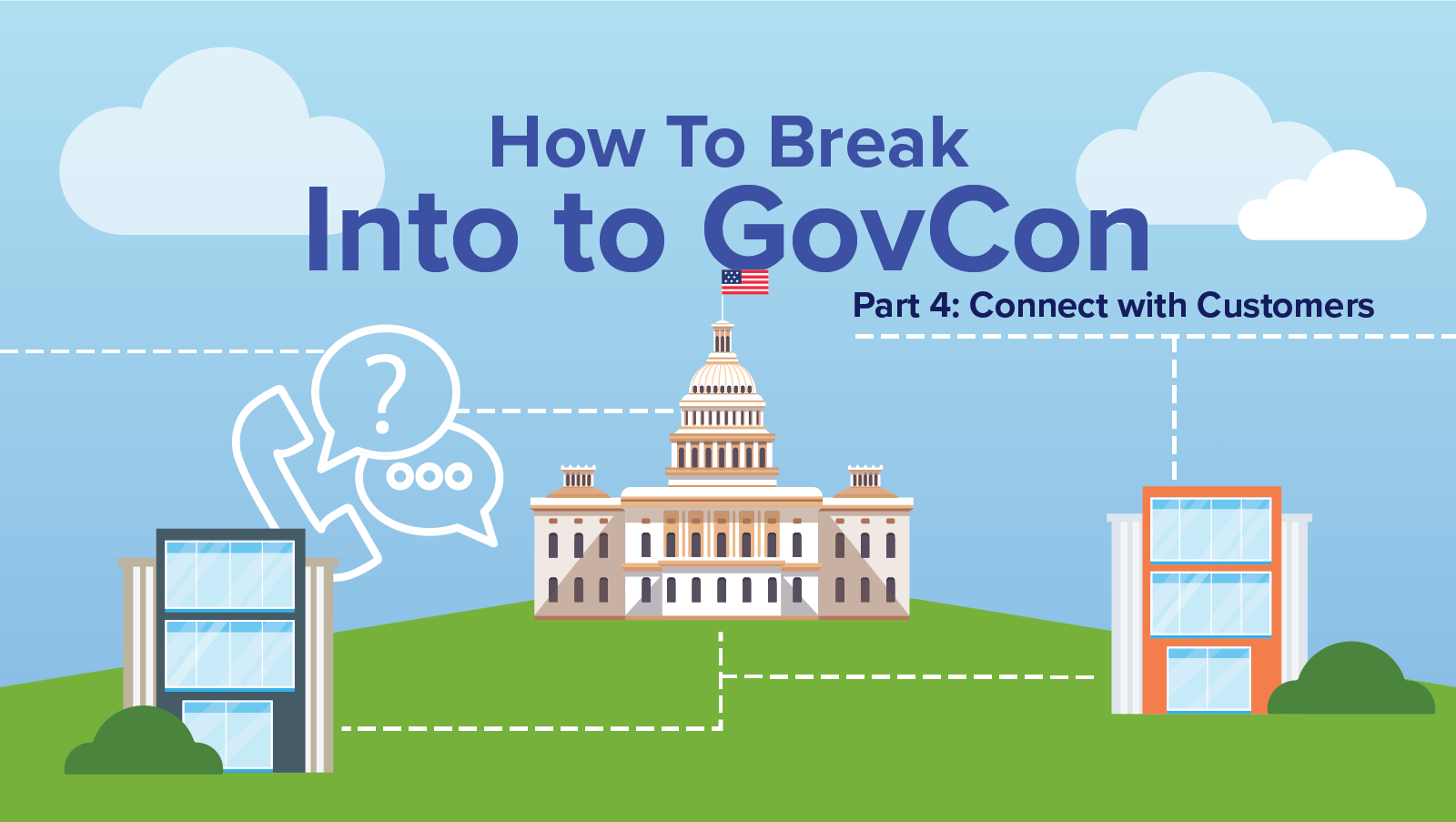
Welcome to the wonderful, wacky world of proposal management!
No doubt, you will be confronted with a lot of dizzying, new, maybe even intimidating experiences, but we’ve all been there. During the first proposal management jobs I assumed, I encountered many new challenges and a few hard-knock lessons that only trial and error could teach.
Here are four common formative moments a rookie proposal manager will face and some tips on how to turn these seeming ordeals into opportunities!
1. Your First SME Struggle
If your Subject Matter Experts (SMEs) don’t give your writers the input they need during proposal development, your proposal will be weaker for it.
The graphic below depicts a simple and solid checklist for securing SME commitment. First, host your proposal kickoff with everybody, including your SMEs’ leadership. Secure buy-in from executive leaders by conveying the necessity of having quality SME input. The leadership will push their team to offer the best input possible.
Another good idea is to ask your SMEs to write a summary of the solutions for their assigned sections, to help advise your writers on the direction they need to go in. Also, advise your writers to craft a “data call” consisting of questions designed for quick and easy responses. Have the writers use the data call’s answers to build their sections—don’t make the SMEs write the proposal if they don’t want to! These are all actions that can be taken as you develop and implement your proposal plan.
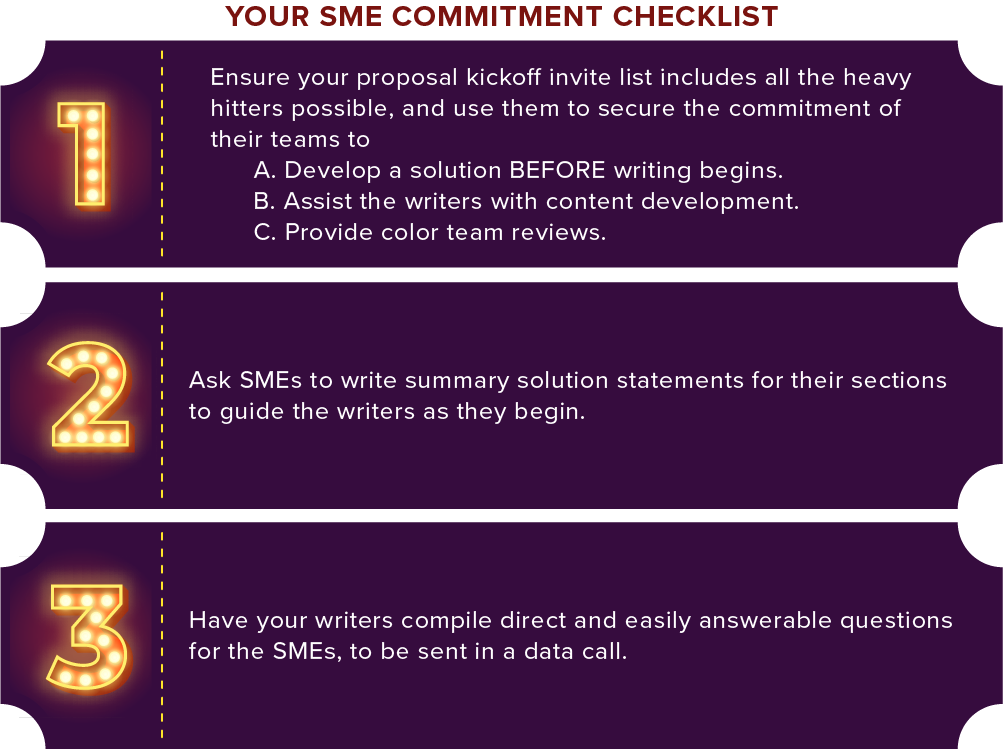
2. Your First Difficult Review Cycle
Maybe your writers didn’t get helpful enough comments in their sections, or maybe there weren’t any comments at all!
Having good review input is vital to your proposal’s success. Often, reviewers are unsure of what constitutes a helpful review. This uncertainty is common when working with SMEs who are not familiar with the proposal process. To mitigate this situation, start each review with a review kickoff. Host a meeting with the reviewers and offer rules and tips on how they can add the most value.
It’s also important to explain and ensure that your SMEs understand the distinctions between Blue, Pink, Red, and Gold Team, so that they can set their expectations and know what kind of input the writers need from them. This improves the quality of their review, and your writers will thank you for it!
Giving your reviewers clear guidelines is especially critical ahead of the Blue, Pink, and Red Team reviews. While Gold Team and White Glove are also important, they occur at the end of the proposal lifecycle, and their purpose is mainly to look for and correct any inconsistencies ahead of submittal.
In-Process Reviews (IPRs) also occur in the days leading up to Pink Team and Red Team and can help provide mid-course corrections, enforce compliance, and facilitate early warning of potential problems. IPRs, however, are conducted by the Capture Manager and Proposal Manager without SME involvement. Therefore, quality SME input is most needed during Blue, Pink, and Red Team.
The Blue Team review is an often missed opportunity to solidify and seek approval for the proposal outline and solution before writing begins. Blue Team is frequently skipped due to tight timelines and other SME commitments, but every proposal manager should lobby for it because it gets SMEs together to articulate and agree on a solution and achieve consensus and common understanding with management and the writers. Blue Team is also a chance for SMEs to match win themes, discriminators, features, and benefits to specific proposal sections. This collaboration is invaluable, as it both vets content before the real writing begins and provides the writers with a skeleton to build the proposal ahead of Pink Team.
Normally, a Pink Team-ready proposal only needs to be 60-70 percent complete and mostly just be a padded-out outline of content. Writers will usually still be struggling to fill solution gaps and gather proof points when developing the Pink Team document and are hoping for reviewers’ comments to help complete and validate the solution. Quality feedback from the Pink review is essential for writers to move to the next stage of the process: Red Team.
In the leadup to the Red Team review, writers strive to integrate win themes and ensure the technical and management sections complement each other and get the document to a 90-95 percent completion goal. The goal of a Red Team reviewer should be to provide ways to highlight the win strategy. A quality Red review means the difference between a fully compliant, compelling, and complete proposal and one the evaluator sees as non-competitive.
To get everybody on the same page and help your SMEs provide productive comments, use the "Reviewer's Guide For Blue, Pink, Red and Gold" table below as your guide and share it with your reviewers during a kickoff call ahead of each review. This will lead to more productive comments, an organized review cycle, stronger writing, and ultimately, more winning proposals!
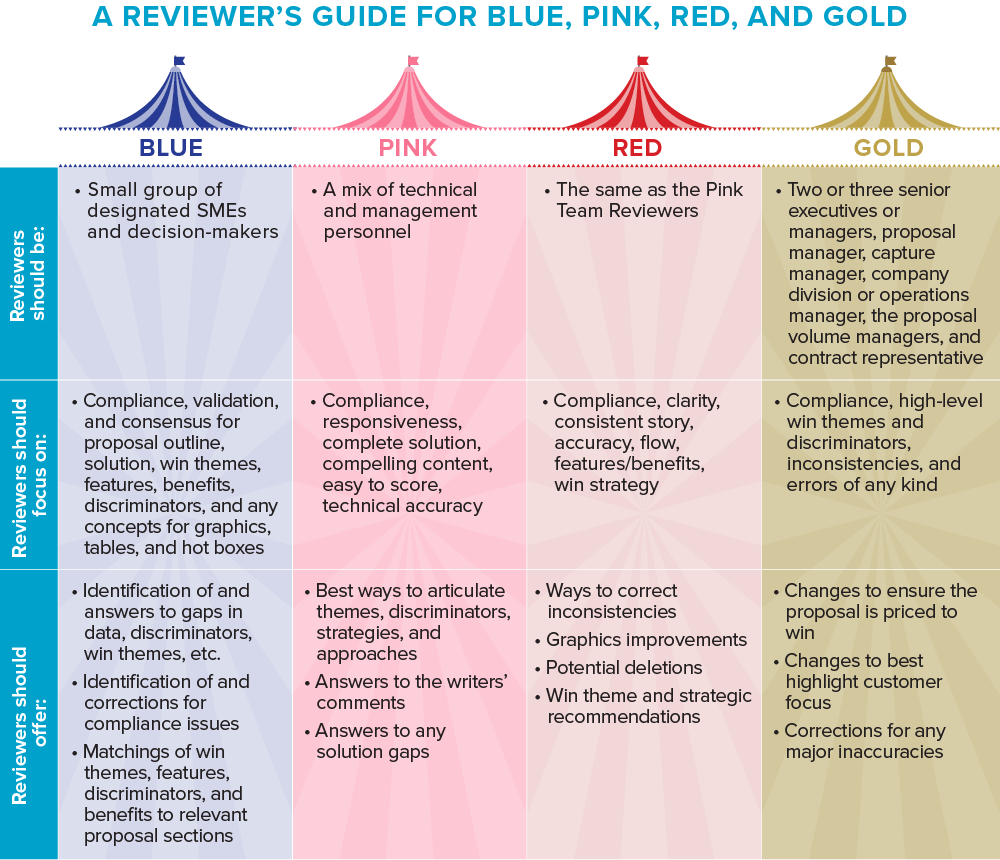
3. Your First Slipped Schedule
Whether it’s caused by an inconvenient amendment or someone missing a deliverable, schedule slippages happen, but they can be mitigated!
Do work before the RFP drops. Starting work on a proposal as early as possible facilitates long-term planning. Have your team pick their key personnel, collect resumes, and build a library of potential boilerplate, proof points, and past performance. Having as much content as possible before kickoff makes for an easier development cycle, and makes schedule slippages less severe.
KSI recommends that companies begin opportunity pursuit and capture activities at least 6 to 18 months prior to a draft RFP release (if applicable), and up to two years in advance if no draft is expected. We also recommend taking the time to reply to any RFIs or Sources Sought. These actions help shape the customer’s understanding of you as an offeror as well as facilitate and expedite the early development of a solution. What gets produced for the RFIs/Sources Sought gives your writers a head start once the RFP drops.
The graphic below depicts KSI’s representation of an ideal timeline for proposal development. As can be seen, the solutioning, win strategizing, and initial templating and outlining should occur before the RFP even drops, to maximize the time spent afterwards developing and refining the proposal package.
A more full and detailed timeline is available in our KSI Advantage™ Capture and Proposal Guide!
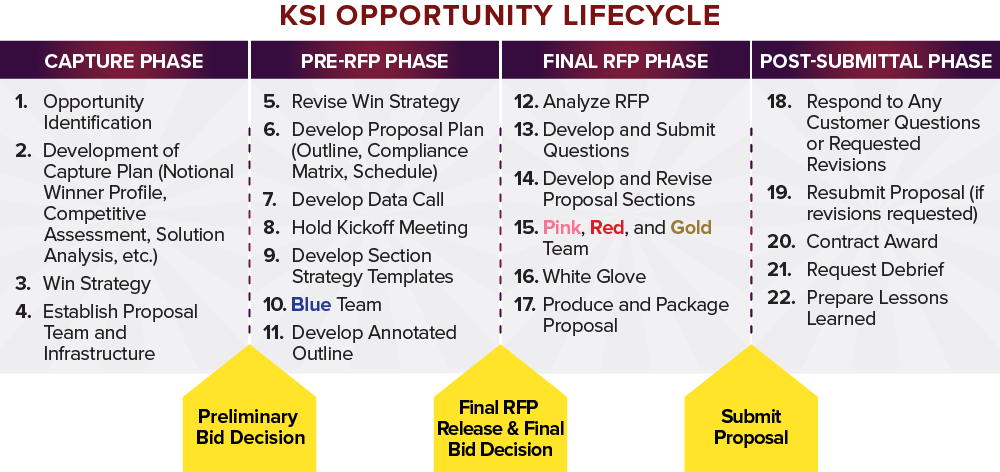
4. Your First Lost Bid
You thought you had all the pieces together, but the customer went with another vendor. It’s disappointing and sometimes feels devastating, but it’s also a chance to learn.
Always advocate asking the customer for a debrief, even if you won. You may not always get one but having documentation on why the customer chose the way they did can help you develop a Strength, Weakness, Opportunities, and Threats (SWOT) analysis on your proposal content and processes. That way, you can find how to improve.
The best debriefs often provide analyses that break out your proposal by evaluated section and detail what the evaluator thought were strengths and weaknesses. A useful exercise is to take the debriefs and itemize them in an Excel spreadsheet or Word document that guides your solution development and proposal writing for each subsequent bid.
Keep this Debrief Log continuously updated as you collect debriefs. In future proposals, ensure you include any strengths that were mentioned and consider possibly evolving them into win themes that echo throughout your proposal. For instance, if the evaluator liked that your staff had a combined century of relevant experience, that’s the makings of a potential win theme.
Likewise, use the Debrief Log to record any identified weaknesses, and set up meetings with SMEs and decision-makers to develop mitigation strategies and find ways to counteract them ahead of beginning the next proposal. For instance, if lack of on-site, on-the-ground support was flagged as a weakness, consider developing a teaming agreement with a subcontractor who could provide the customer in-person help.
The table below is an example debrief log based on actual responses I’ve seen in debriefs. It’s a good guide for how to template your proposal’s strengths and weaknesses as stated by the evaluator, and features the kind of strategizing and brainstorming that should occur after receipt of a debrief.
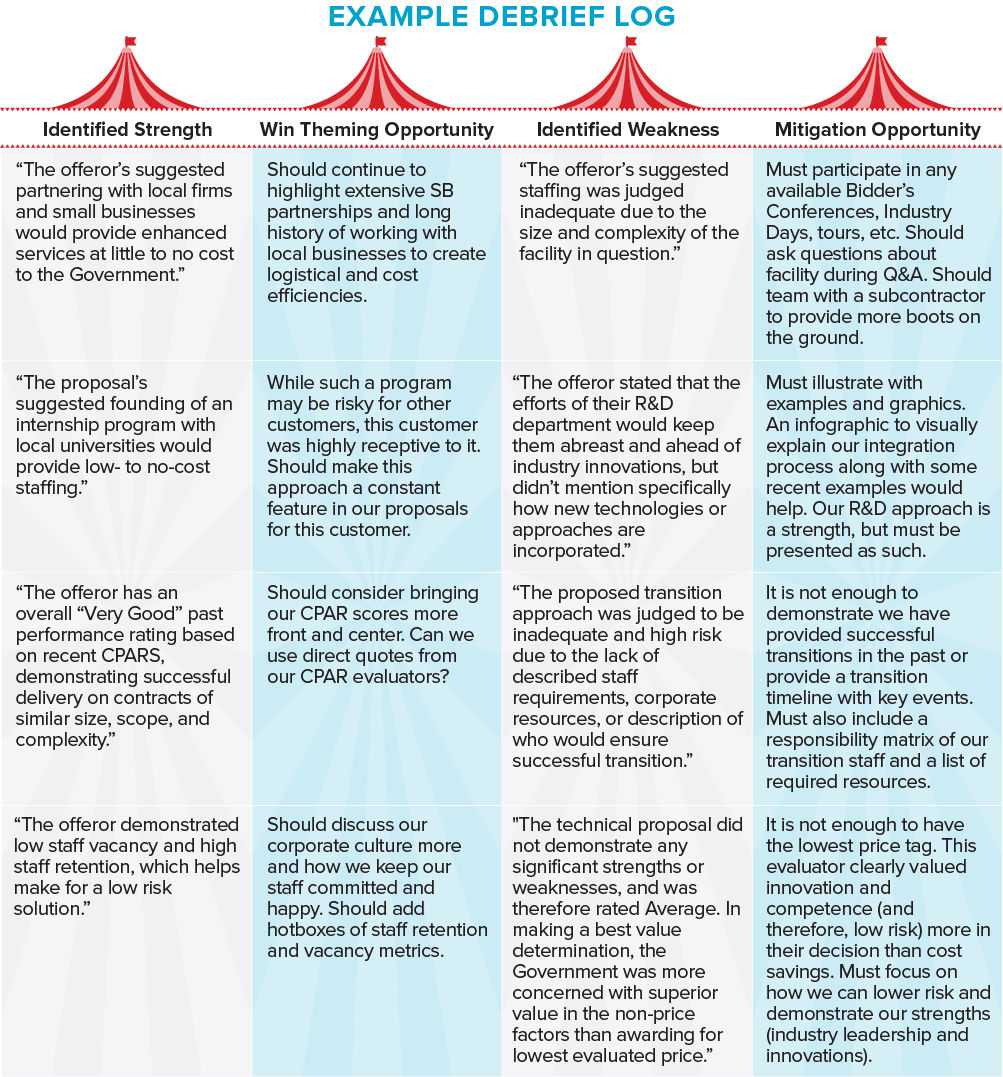
Conclusion
My initial proposal management experiences were definitely replete with some hard-won lessons and new challenges that required me to adapt quickly. But because of those experiences, I learned the strategies discussed in this article and walked out a stronger manager and proposal professional.
You too can improve your management skills and have a smoother proposal lifecycle by securing SME commitment early on, adequately briefing your reviewers, starting proposal development as much in advance as possible, and analyzing and evolving from your debriefs. Tips like these, along with the other components of the KSI Advantage™, are the difference between a hectic, disorganized proposal effort and one that is planned, productive, and conducive to winning!



